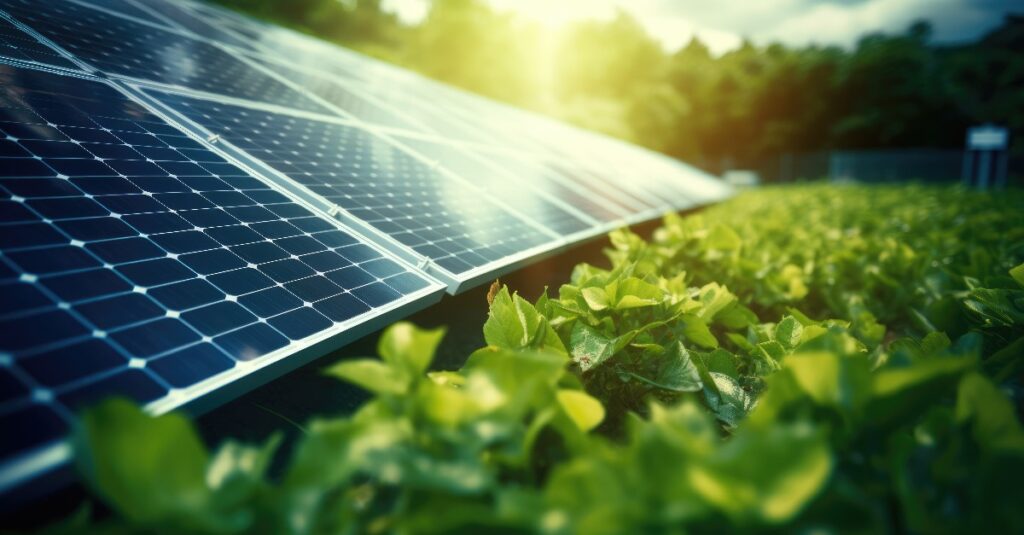Agrivoltaics

The topic of energy production for the future of our planet is a dividing one, to say the least. The
notion of non-renewable vs. renewable resources, the growing global population, and a rise in air
pollution and climate change are some areas of contention that can get a person up in arms really
quickly. You might even be a little tense yourself now. Regardless of your stance on the matter,
the issues surrounding the production of energy are ones that we must all face. It’s inevitable and
it’s important.
At the beginning of this year, I attended the annual American Forage & Grassland Council
conference where I heard a man speak on the topic of agrivoltaics. The term agrivoltaics was
relatively new to me, which may be the case for you as well, but I was enthralled by his
presentation. He boldly stated that a sheep was worth more to him as a lawnmower than it was as
meat. So down the rabbit hole I went…
Agrivoltaics from a USDA definition is the use of land for both agriculture and solar
photovoltaic energy generation. This is a form of dual-use solar where those two processes
(agriculture and solar energy production) are occurring on the same piece of land. Picture a plot
of land. If that plot is being used solely for agricultural production it has a certain value, if the
plot is being used solely for energy production it has a certain value, but if the plot can
successfully produce both, then the two combined uses have a higher total value than each would
individually. In addition, new findings are beginning to suggest that agriculture and solar panels
may even have complementary impacts on one another. There is a symbiotic cooling effect
where the solar panels provide shade for plants and the plants give off water vapor that helps to
cool the photovoltaic panels.
I guess now we ask what the possibilities for agriculture underneath solar panels are. There are
over 2.8GW of agrivoltaics sites in the US. The most common uses are for pollinator habitat and
sheep grazing; however, more research and practical applications can suggest effective
production with other livestock and poultry, hay and silage, grains and vegetables, and fruits and
berries. Currently, the largest agrivoltaics site in the U.S. is on a blueberry farm in Rockport,
Maine used for research by the University of Maine Cooperative Extension and is 10 acres in
size producing 4.2 megawatts of power. Alternatively, the integration of solar panels with pasture
is another common practice. Solar grazing, as it is termed, uses sheep to decrease mowing costs
while providing feed, the shepherds get contracts and are paid to graze their sheep as mowers,
and the mowing helps to keep the solar areas safe while also using less fuel and reducing
emissions.
The United States Department of Energy has launched a program called InSPIRE to support
solar development in conjunction with agriculture. The project is managed by the National
Renewable Energy Laboratory in collaboration with several universities running 22 sites across
the nation. You can visit the following website to learn more about the InSPIRE core research
ideas and ecological and economic impacts of agrivoltaics: https://openei.org/wiki/InSPIRE.
There are also two very recent bills to the senate, the Pollinator Power Act and the Agrivoltaics
Research and Demonstration Act, which show governmental support and an increased quantity
of federal funds to further develop the field of agrivoltaics.
Don’t get me wrong, this technology is so cool and so inventive, but I am not suggesting that all
Alaskans go out and build themselves a solar field with vegetables or hay growing underneath.
Because truthfully that probably won’t work very well. What I am suggesting is that we need to
be more innovative in our approach towards the utilization of resources. In 2022, renewable
energy sources accounted for 13.1% of total U.S. primary energy consumption and this number
can only continue to rise when we look to solutions such as agrivoltaics that combine existing
technologies. So, think outside of the box and see if you’ve got any sheep that may be worth
more as a lawnmower than as meat.
Written by Nikira Lane, agAlaska Ag Tech Specialist


Comments are closed